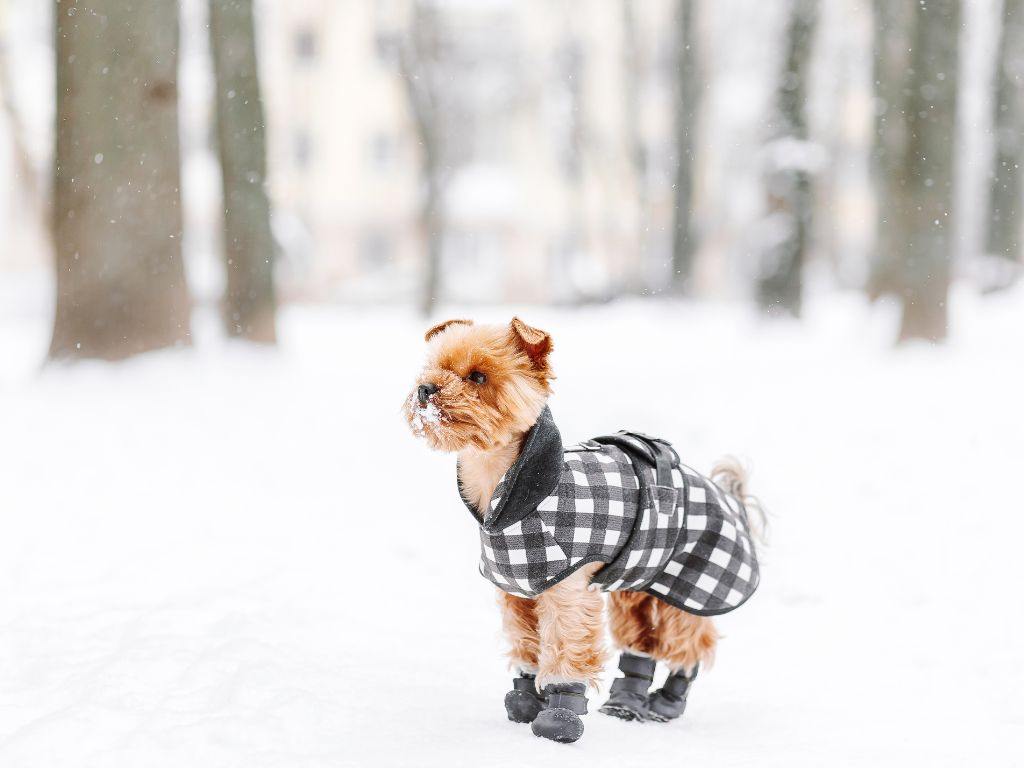
Dogs have different tolerance levels to cold depending on their fur, size, health, and age. The tolerance to cold also varies based on the weather conditions, the time of exposure, and the type of outdoor activities. But as a general rule, vets recommend caution in temperatures below 45 degrees Fahrenheit.
This year’s winter is supposed to be milder compared to previous years. However, in some places, the temperature can still easily drop below 45°F. For instance, where I live on the East Coast temperatures are already falling between 40°F and 35°F— and believe me that it’s mild for this time of the year.
So, as dog caregivers, it is important to be aware of the health implications of cold weather and to take necessary precautions to keep our furry friends safe.
In this article, we will review the factors to consider when determining whether it is safe for your dog to be outdoors in chilly weather.
At What Temperature Is It Unsafe for Dogs to Be Outside?
Temperatures below 45 degrees Fahrenheit (7° C) may be potentially unsafe for medium and small dogs. Bigger dogs with heavier coats may be okay until temperatures of 20 degrees Fahrenheit (-7° C). Below that, any dog is at higher risk of hypothermia and frostbite.
When you are out with your dog, always pay attention to signs that indicate they are feeling cold like shivering, reluctant to continue walking, whining, acting anxious, seeking shelter, and ears, paws, and tail cold to the touch.
Signs of Hypothermia in Dogs
Hypothermia is a serious condition when a dog’s body temperature drops below a safe level after prolonged exposure to cold temperatures. For reference, a dog’s normal body temperature is 100°F (38° C) and in hypothermia cases, the temperature drops below 95°F (38° C).
Signs include:
- Shivering
- Weakness or lethargy
- Pale gums
- Difficulty breathing
- Frostbite (particularly on the paws, ears, and tail)
- Muscle stiffness
If you notice any of these signs, it’s important to seek immediate veterinary attention and warm your dog up slowly while waiting for professional help.
Understanding a Dog’s Cold Tolerance
What makes some dogs better tolerate cold temperatures than others depends on several features, including:
- Coat type: Breeds like Huskies, Malamutes, and Newfoundland are better equipped for cold weather because of their thick and doable coated fur, but are also more prone to shed year-round.
- Coat color: Darker coat colors such as black or brown absorb more heat from the sunlight.
- Size: Larger dogs conserve body weight more efficiently because the larger the dog the less surface area per weight.
- Weight: Body fat acts as an insulator. That’s why thin dogs tend to have less tolerance to cold weather as they have less body fat.
- Age: Puppies and senior dogs can’t regulate their body temperature as well as healthy adult dogs.
Let’s see some examples:
Breeds with High Cold Weather Tolerance:
Siberian Husky
Huskies are the ideal sled breed because of their strength and endurance. They only weigh between 30 to 60 pounds and have lots of energy.
Alaskan Malamute
They are an old sled dog breed native to Alaska. They weigh between 75 and 85 pounds and have high energy levels.
Newfoundland
They are known for their strong swimming skills and used to work on fishing vessels on the coast of Newfoundland. They weigh up to 150 pounds and are friendly dogs.
German Shepherd
These are working dogs and require a lot of exercise and mental stimulation. They weigh between 50 and 90 pounds and are loving and loyal.
Breeds with Low Cold Weather Tolerance:
Greyhound
Chihuahua
Boxer
Pitbull
Weather Factors to Consider
Before going out, check not only the temperature but also other factors that impact your dog’s ability to remain warm, such as:
- Wind chill: The cold breeze decreases your dog coat’s ability to insulate against the cold.
- Moisture: Rain, snow, or heavy fog will soak your dog’s fur and make them feel colder.
- Activity levels: Will your dog be active outside or remain steady? If they are walking and moving, their body will create extra heat and keep them warm, but if they are not doing any physical activity they will get cold easily.
- Duration of exposure: For small warm weather breeds, like Chihuahuas and Greyhounds, it’s recommended to spend no more than 10 to 15 minutes outside when the temperature drops below 32°F. Medium and large warm weather breeds, such as Boxers and Doberman Pinschers, can stay outside for up to 30 minutes if they are heavily exercising, or for 10 to 15 minutes for relieving themselves.
5 Tips to Enjoy Your Winter Walks
- Plan your walks during the warmest part of the day, that is when the sun is out and the temperature is at its peak.
- Dress your dog with proper winter clothes, such as insulated jackets and booties.
- Keep the walks active and short.
- Take care of the paws as they may be in contact with ice, salt, and other chemicals to melt the ice. Trim the hair around the pads to avoid collecting ice and debris, wipe their paws after every walk, and finish applying balm.
- Avoid ice surfaces.
Final Thoughts
As we head into the winter season, we recommend taking precautions to ensure that your dog can continue to enjoy his walks. Consider your dog’s physical characteristics and take into account the weather conditions to determine his tolerance to cold. Always keep an eye out for signs that indicate he may be feeling chilly. It’s also a good idea to limit your dog’s exposure to the cold weather and plan your walks ahead of time.
🐕❄️⛄️
Reference
Dogs & Cold Weather: How Long Can My Dog Be Outside?
Recent Posts
Is the Dogo App Worth It? Honest Review After Training My Dog
Training your dog shouldn’t feel like another chore, but it often does because, unless you’re a professional trainer, you have to research everything yourself first. And that research can take...
Amazon's Top Black Friday and Cyber Monday Deals for 2024: Dog Products Edition
The holiday shopping season has officially started and Amazon has already released some incredible deals on pet products for Black Friday and Cyber Monday 2024. Here is our curated list of the...
